|
 History
History| The Ginkgo tree is the only
living representative of the order Ginkgoales, a group of gymnosperms composed
of the family Ginkgoaceae consisting of about 19 members with its earliest
leaf fossils dating back to 270
million years ago in the Permian period, so in the era of the dinosaurs
(Jurassic 213 million years ago) it already existed. Fossil leaves and
vegetative organs show that at that time there were several species. During
the Middle Jurassic there was a great increase in species with a
maximum diversity during the Cretaceous period (144 million years ago)
in areas now known as Asia, Europe and North America. It was common and
widespread for a long time.
Due to geological cataclysms only three (or four) species were left (Ginkgo adiantoides, Ginkgo jiayinensis and Ginkgo gardneri) in the Tertiary (65 million years ago). The extinction of the dinosaurs as potential seed dispersers of the large seeds may also have influenced this decline, which is in line with the fossil records. Read more about seed dispersers on my Propagation-page. About 7 million years ago the Ginkgo disappeared from the fossil record of North America. It was gone from Europe by about 2.5 million years ago. |
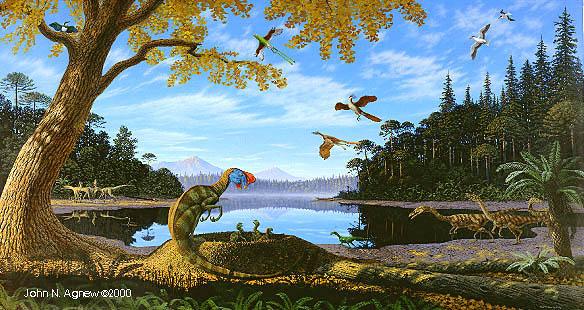 |
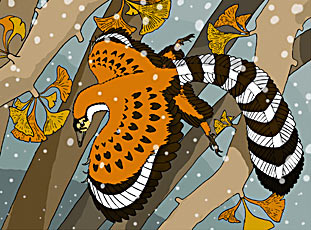 |
The fossil findings show that
the Ginkgo prevailed under moist and moderately warm climates since the
Mesozoic era.
|
(with fossil picture gallery and maps): Fossils-page. |
| Scientists thought
that it had become extinct, but in 1691 the German Engelbert
Kaempfer* discovered the Ginkgo in Japan.
The Ginkgos had survived in China and there they were mainly found in monestaries
in the mountains and in palace and temple gardens, where Buddhist monks
cultivated the tree from about 1100 AD for its many good qualities.
From there it spread (by seed) to Japan (around 1192 AD with some
relation to Buddhism) and Korea.
Ginkgo-seeds were brought to Europe from Japan by Kaempfer in the early 1700's and in America later that century. Most of the earlier trees raised in Europe appear to have been males. The first recorded female tree was found near Geneva in 1814 of which scions were grafted on a male tree in the Botanic garden of Montpellier where the first perfect seed has grown. Now the tree grows in many countries all over the world as an ornamental tree. Read further on my Where-page about them. |
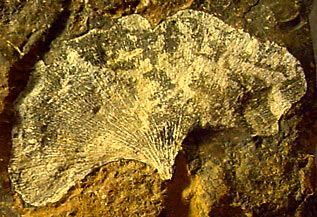
Ginkgo adiantoides Naturalis, Leiden Photo Cor Kwant |
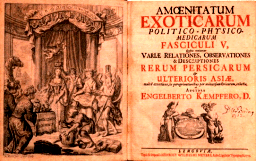
click on picture to enlarge and more details![]()
| *
Engelbert
Kaempfer
was a German physician and botanist who was in Japan from 1690 till 1692 sent on a mission by the Dutch East-India Company. He discovered Ginkgo trees there (1691) and described the Ginkgo in his work "Amoenitatum exoticarum" (1712). Later he brought Ginkgo-seeds
to Holland. In the Botanical Garden in Utrecht one of the first Ginkgo
trees was planted, where it can still be seen today - Click
here In 1754 it was cultivated in the nursery of James Gordon of London and in Kew Botanical Gardens (1762). From there and from Japan it spread to other European countries, later in 1784 also to the USA to William Hamilton's garden near Philadelphia (read below). By the late 1800s/early 1900s it was a popular streettree on the east coast in urban areas. |
|
The Chinese Ginkgo
biloba survived essentially unchanged. From the Jurassic till now there
was a reduction of individual ovule-stalks and a decrease in the number
of ovules. The size of the ovules increased.
The ovulate organs may find their origin in the Jurassic Ginkgo yimaensis (170 million years ago). Fossilized leaves and reproductive organs from the Lower Cretaceous period (new species found in the 121 million years old Yixian Formation in N.E. China) show that their morphology has changed little until now. Ginkgo adiantoides from the Tertiary period (56 million years ago) is remarkably similar to the modern Ginkgo biloba.
The term "living fossil" used
by Darwin in his 'Origin of Species' of 1859 definitely fits the Ginkgo.
|
| Ginkgo, with its spreading rigidly ramified branches and curiously shaped leaves is a tree of great distinction and dignity in appearance. Human history appears insignificant when compared with the genealogy of this tree which now stands in the gardens and along city streets created by man who appeared millions of years later. As the paleobotanist, Sir Albert Seward (1938) remarks: "It appeals to the historic soul: we see it as an emblem of changelessness, a heritage from worlds too remote for our human intelligence to grasp, a tree which has in its keeping the secrets of the immeasureable past." (Li HL 1956). |
| Wild
Ginkgo biloba trees
Questions about the extent of Ginkgo biloba’s native
range in China have been the subject of debate among botanists for well
over a hundred years.
A refugium occurs in southwestern
China especially around the southern slopes
of Jinfo Mountain (Jinfo Shan) of Nanchuan County at the boundary
of Chongqing Municipality and Guizhou Province (see area map; 28°53'N;
107°27'E). Ecological work in this area, as well as in adjacent parts
of Guizhou Province, has identified numerous small populations, for instance
in Wuchuan County and Tuole (Panxian), that can be considered to be either
wild or remnants of wild plants.
Ginkgos in eastern China,
e.g. on West Tianmu Mountain, Zhejiang province:
this nature reserve is an another refugium for wild Ginkgo biloba communities.
A third refugium has been genetically classified in southern China e.g. in Fujian province. |

wild Ginkgo biloba forest, 35 m height, limestone, Yangjiagou, Nanchuan County
Forest of wild Ginkgo biloba
trees,
38 m height, limestone, Xiangshuiyan, Fenggang County
|
|
Jinfo Mountain,
a biodiversity hotspot Tian Mu Shan Reserve
click photo to enlarge + more photos photo © Peter Del Tredici |
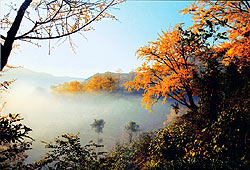 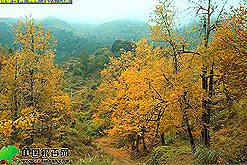 Fujian Province, Youxi
|
In the oldest Chinese
literature
the Ginkgo is not mentioned, but in the 11th
century (Sung dynasty) it appeared in
the literature as a plant native to eastern China. In a poem by Ou-Yang
Xiu is written: "Ginkgo grows south of the Yangtze River, the name
coincides with its substance. Since the nuts have been used in tribute,
then it is considered precious in the Capital. " In a notebook of the Sung
dynasty (Shi Hua Chung Kuei) is said: "In the capital (Kaifeng) there was
originally no Ya Chio (Ginkgo). Since Prince Li Wen-ho (1st half 11th century)
came from the south and transplanted it to his residence, it became famous.
From then it gradually propagates and multiplies, and fruits from the south
are no longer considered precious." From that time on the Ginkgo is depicted
on Chinese paintings and appeared in poetry. Ou-Yang: "The first 3-4 seeds
this Ginkgo produced were presented to the emperor in a golden bowl. After
a few years the trees bear more fruits. The owner presents the nuts like
giving pearls."
Many famous poets praised its
'fruits'and sometimes also its leaves. Especially the poets Ou-Yang Xiu
and Mei Yao-ch'en, who had both official positions in the capital Kaifeng,
exchanged verses about the Ginkgo when Mei moved to the south near the
Yangtze River. Mei sent seeds from a tree in his own backyard to Ou-Yang
Xiu.
The seed is often compared with
the walnut by Sung-poets which was a popular fruit of the north.
The Ginkgo might have been known
to the northern Chinese before the Sung dynasty but it was very rare and
not in cultivation. According to the Contemporary Ginkgo Encyclopedia of
China the edible nuts were a food source since at least the Han dynasty
(206BC-220AD). The seeds were not mentioned in herbals until the Yuan Dynasty
(1280-1368) in Li Tung-wan's 'Edible Herbal' (Shih Wu Pen Ts'ao) and the
1350 work, Wu-Jui's 'Herbal for Daily Usage' Jih Jung Pen Ts'ao.
In Pen Tsao Kang Mu (1578) is mentioned that the nuts are consumed
at weddings (the shell being dyed red), are much used at feasts and are
a fair substitute for lotus seeds ( Stuart/Porter Smith).
After the Sung and Yuan
dynasties Ginkgo seems to be widely cultivated all over China. There seems
to be no association with religious institutions; it has always been the
custom of the Buddhist as well as the Taoist priests to preserve venerable
species on temple grounds. Very old trees are often revered and preserved
because of age and not kind.
The Ginkgo is also mentioned
in the botanical work Chih Wu Ming Shih Tu Kao of 1848.
The
famous writer and historian Guo Moruo published an essay in which he mentions
the Ginkgo a wonder and the victory of humanity over nature.
The Ginkgo nuts are mentioned in Japanese textbooks from 1492 and later for use at tea ceremonies as sweets and dessert. In the Edo-period (1600-1867) common people began to eat them as vegetable and ingredients for pickles. In this Edo-period Ginkgo trees were connected to shape-shifters and spirits and not planted in gardens (possible influence of the assassination of Minamoto no Sanetomo under a Ginkgo tree near the temple of Tsurugoaka in 1219). In the 18th century the nuts (called ginnan) became used as a side dish when drinking sake. Today they are used (grilled or boiled) in chawan-mushi (a pot-steamed egg dish) or in nabe-ryori (Japanese fondue). The grilled nuts are still often eaten in Japan when drinking sake.
|
1856 - 1925  |
Hirase
was a drawing technician and was employed in 1888 at the College of Science,
Imperial University (now University of Tokyo) to draw plant specimens.
He became a research assistant and learned himself the technique of botanical
studies and since 1893 began to observe the period of fertilization and
embryo formation in Ginkgo biloba.
Below are pictures of the tree round 1900 and the same tree nowadays. |
His
revolutionary discovery of the swimming sperm in a seed plant was
first published in Japanese in the Botanical Magazine Tokyo of October
1896
and came to be known throughout the world.
Hirase proved that the Ginkgo had an intermediate position between ferns and conifers and therefore Professor M. Engler established a new family Ginkgoacea (1897), order Ginkgoales (1898). |
| Shortly after
Hirase's discovery Ikeno discovered such sperm in Cycas revoluta. Hirase
and Ikeno were awarded the Imperial Prize of the Japan Academy in 1912.
One year after his discovery Hirase resigned as an assistant and became a school teacher of a middle school, possibly caused by his unpleasant position not having a university education. |
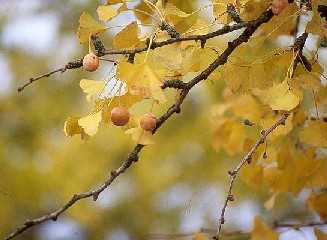 |
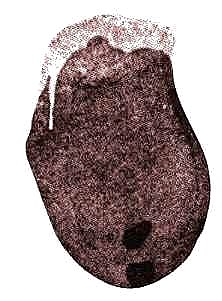 |
| In
his time his scientific efforts were very much appreciated by his collegues
and the Botanical Society of Japan. Ikeno, who was an assistant professor,
later became Professor of Botany at Tokyo Imperial University and wrote
an obituary when Hirase died in 1925.
Their brilliant researches stimulated Japanese botanists so vigorously that they were able to make valuable contributions in the 20th century. |
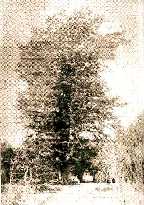 |
 |
photos: Botanik Online and Didactiel de Biologie Végétale
| The
seeds
(baigo)
are most used in Traditional Chinese Medicine, the leaves in western medicine.
In Japan the seeds are called ginnan. The Japanese way of using Ginkgo as a medicine originates from the Chinese tradition. The seeds' medicinal use is mentioned
in the 'Great Herbal' Pen Tsao Kang Mu compiled by Li Shih-chen
(1578) which in still in use in TCM.
|
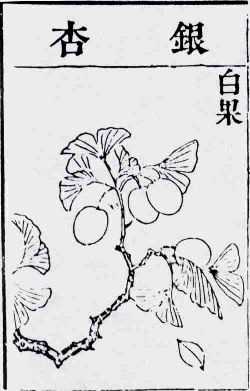
Illustration in Pen Tsao Kang Mu of Ginkgo with seeds (1578) |
Eaten
raw they destroy cancer and are counter-vinous. Cooked they are said to
be peptic and anthelmintic, and are similarly used by the Japanese to promote
digestion.
In some cases they appear to cause peculiar symptoms of intoxication." They also mention the use of the wood for seals used as charms by quacks in the treatment of disease. Kaempfer mentions the seeds as an aid for digestion and bladder. Thunberg writes in Flora Japonica (1784) that the seeds are eaten raw or roasted in Japan and in 1819 Franz von Jaquin notes in 'Ueber den Ginkgo' the use as a digestive aid. |
The earliest record of the use
of the leaves
as a medicine is said to be mentioned in the Chinese Materia Medica Shen
Nung Pen Tsao Ching (which should originate from about 2800 BC or from
the Han dynasty [206BC-220AD]) as an aid for blood circulation and the
lungs. This record cannot be confirmed however because the original
of this work has never been found.
Dian Nan Ben Cao (Lan
Mao) (1436) mentions the use of the leaves for skintreatment, head sores
and freckles. They are also used for chilblains and as a wound plaster.
The internal use is first mentioned
in the
Ben Cao Pin Hui Jing Yao (1505) by Liu Wen-Tai as used against
diarrhea.
In 1932 the Japanese Furukawa
isolated the
ginkgolides
for the first time, which were further
investigated for their chemical structure by Nakanishi in 1966.
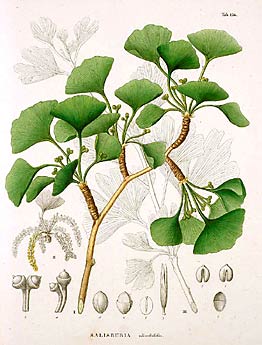
enlarge picture From 'Flora Japonica' by Siebold & Zuccarini, Leiden 1835/42. |
In the late 1950s western medicine began to study its medicinal uses. Dr. Willmar Schwabe Company produced the first extract from the leaves in 1965 (Egb 761). Dr. Elias J. Corey of Harvard University received the Nobel prize for chemistry in 1990 for among others the total synthesis of Ginkgolide B in 1988. Nowadays Ginkgo is prescribed
in Europe and used by many people in the U.S., Canada and other countries
for its medicinal abilities.
In traditional Indu medicine it is a constituent of an elixer called "Soma". For the usage of the seeds and
the leaves read my Usage-page.
|
|
At the end of World War II on
August 6th 1945 an atomic bomb was dropped on Hiroshima by the Americans.
The plants and trees in the area around the epicentre were examined in
September 1945.
Six atomic bombed Ginkgo trees
are still alive. Therefore it is regarded
as the
|
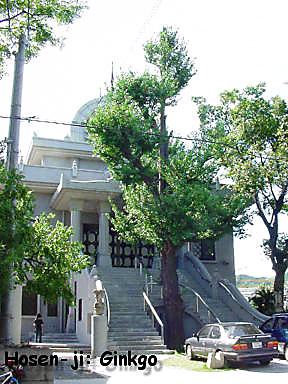
photos © Mandy Conti |
|
|
|
about A-bombed Ginkgo trees in Hiroshima.
Documentary
by France5.
|
| Dr.
David Hosack, physician-botanist and founder of the former Elgin Botanic
Garden in New York City, planted in the beginning of the 19th
century a Ginkgo tree on his estate above the Hudson River in Hyde Park,
New York.
|
In 1798 Gardiner Greene moved into a house on Pemberton Hill in Boston where a Ginkgo tree already grew in the garden. When Greene died in 1835 this tree (about 10 m/30 feet height) was transplanted to the Common as a gift of Greene's children to the citizens of Boston. A special cart was constructed to transfer the Ginkgo, which was discussed much in the press because of the costs that had to be paid partly by taxpaying citizens... |
From an interesting notice of this remarkable tree in the "Philadelphia Ledger" August 29, 1889, remarking on its fruiting for the first time in that city, in the grounds of Mr. Charles J. Wister, Germantown, and communicated to us by Mr. A. Garman, of Philadelphia, we make the following extracts:
" The tree itself has a very
remarkable history. It is asserted by eminent horticulturists that it has
been found wild nowhere on the earth, but it is cultivated largely both
in China and Japan, where it is usually found near the temples and similar
religious structures.
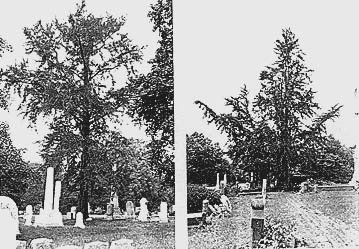
Woodlands Cemetery, Philadelphia male (left) planted by William Hamilton in 1784 and female (right) tree One tree was still alive in 1981 but has since been cut down. Photo courtesy Peter Del Tredici. (from Del Tredici P, 1981, 'The Ginkgo in America', Arnoldia 41) |
" The first specimen received
in this country was presented by William Hamilton, the former owner of
the beautiful grounds in which the celebrated explorer, Pursh, was gardener
at what is now known as Woodlands Cemetery. This particular tree is still
regarded as one of Philadelphia's arboreal treasures, and tree lovers from
distant parts of the globe, when in this city, Journey to the cemetery
expressly to see this magnificent specimen.
" When the original tree that was imported from Japan flowered it was found to have male flowers only, and consequently all trees propagated by cuttings were male also. The tree in Woodlands is a male tree. It has only been a comparatively few years since seeds have been introduced from China or Japan, and among these young seedlings, plants with female flowers were found. This tree of Mr. Wister's happens to be female, and now that it has come of age it produces fruit. |
| Numerous seedling
trees have been distributed over different parts of the United States,
and it is expected that others will reach the fruiting stage before many
years.
There is a magnificent avenue of Ginkgo trees on the grounds of the Agricultural Department at Washington, the trees having been sent there from Pennsylvania nurseries after Mr. Charles J. Wister. " The fruit itself is about the size of a large cherry, and is of a greenish-yellow color when ripe. Like the cherry, it has a fleshy pulp with a single stone or seed in the interior. To most persons the odor of the fruit is very disagreeable, but the fruit plays a very important part in Chinese gastronomic arts. The grand dinners of the Chinese usually last all day, and every help to digestion is needed in order that the guests may experience the fullest enjoyment. The fruit of the Ginkgo is the chief element in promoting this desirable result. They are first slightly roasted, and then placed in small plates by the side of the guests, who every now and then take one between courses, as an American or Englishman would an olive. Mr. Wister states that the odor of the fruit of his tree is very disagreeable, and those who have handled the fruit can scarcely credit its use as described by the Celestials. |
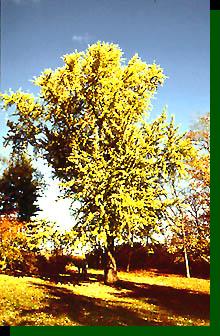
The Bartram Ginkgo, presumbly a sibling of Hamilton's tree, is now the oldest in North America, planted about 1785. Photo courtesy the John Bartram Association. |
" The paleontologists and evolutionists are also much interested in the Ginkgo although, as already stated, no wild localities are known where the trees grow, it has been discovered by its fossil remains to have been once widely scattered over the face of the globe. It is probable that it is only through its having commended itself by its beauty and other good qualities to the Chinese and Japanese gardeners, that it has been able to survive those geological cataclysms under which the old race has been cleared away from the surface of the earth. It is classed with the coniferous trees, notwithstanding its fern-like foliage, its closest relation being the yew family; but as there is nothing very closely resembling it, the paleontologists believe that an immense number of what have been is wholly swept away."
'Takakurajinja no icho' with chichi
girth 8,1 m, height 29 m
Aomori Prefecture, Northern - Honshu, Japan
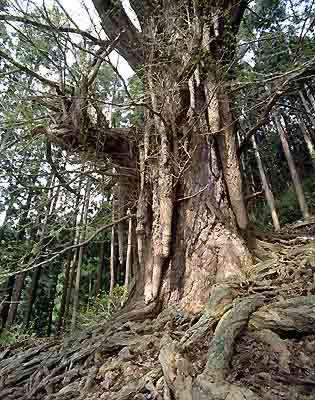
photo © Hiroshi Takahashi
![]()
© Cor Kwant ![]()
Copyright information.